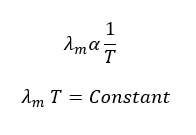Laws Of Radiation Heat Transfer – Wien’s Law, Kirchhoff’s Law And Stefan-Boltzmann Law
Wien’s displacement law and equation
Wien’s law states that in a black body radiation the wavelength of radiation corresponding to the maximum energy is inversely proportional to the temperature of the body.
Let λm=Wavelength at maximum energy
T = Temperature of body.
Then according to Wien’s law
The Constant is known as Wien's displacement constant, and it is equal to 2.897771955….×10−3 m K
According to the Wien’s law, at lower temperature, higher the wavelength of maximum energy radiation, and at a higher temperature the lower the wavelength of thermal radiation. That is why in visible spectrum of radiation, the very hot object emits bluer light than the cool object.
Kirchhoff’s law of thermal radiation
Kirchhoff’s law states that the emissivity of the body at a particular temperature is numerically same as the absorptivity of the body at the same temperature.
absorptivity α = emissivity ɛ
Stefan-Boltzmann law of radiation
Stefan-Boltzmann law states that the emissive power of the black body is directly proportional to the fourth power of its absolute temperature.
σ = Constant of proportionality known as Stefan–Boltzmann constant
Equation for heat transfer by radiation
Consider two bodies at temperature T1 and T2
Where T1>T2
Then Heat transfer through radiation will be Q
Q = Q1-Q2
According to Stefan-Boltzmann law
Where σ = Stefan-Boltzmann constant = 5.67 x 10-8wm-2K-4
F = A factor depending on geometry and surface properties
F =1 in the case of black body entirely enclosed by other body.
F = emissivity (ɛ), for non-black body enclosed by other
A = Area of the body in m2
T1 and T2 = Temperature in kelvin, K







